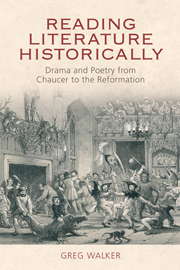Book contents
- Frontmatter
- Contents
- Acknowledgements
- Dedication
- Introduction: Literature and History: The Risks of Conversation
- Part I Drama
- Part II Poetry, 1380–1532
- 4 Courtesy and Chivalry in Sir Gawain and the Green Knight
- 5 The Plowman's Tale and the Politics of 1532: A Cautionary Tale?
- 6 Rough Girls and Squeamish Boys: The Trouble with Absolon in The Miller's Tale
- Index
4 - Courtesy and Chivalry in Sir Gawain and the Green Knight
from Part II - Poetry, 1380–1532
Published online by Cambridge University Press: 05 October 2013
- Frontmatter
- Contents
- Acknowledgements
- Dedication
- Introduction: Literature and History: The Risks of Conversation
- Part I Drama
- Part II Poetry, 1380–1532
- 4 Courtesy and Chivalry in Sir Gawain and the Green Knight
- 5 The Plowman's Tale and the Politics of 1532: A Cautionary Tale?
- 6 Rough Girls and Squeamish Boys: The Trouble with Absolon in The Miller's Tale
- Index
Summary
Among late-medieval texts, the anonymous late fourteenth-century verse romance, Sir Gawain and the Green Knight is perhaps uniquely deeply rooted in the protocols and textures of the elite societies that it describes, both in the rich evocation of King Arthur's court at Christmas in fitt (section) one, and the subsequent, even longer description of the life of the northern aristocratic household of Bertilak de Hautdesert in which Sir Gawain finds himself over the Christmas and New Year festivities twelve months later. As such it offers a detailed and informed examination of late-medieval conventions of courtliness and chivalric culture seemingly described from the inside, by a writer with a deep investment in the cultures he is describing and who understood the stresses and pressures which threatened them, both from within and without.
In the magnificent first fitt the poet revels in, and imaginatively inhabits each phase of the courtly entertainment that he describes. This is not mere background for the story to follow. The poet lingers lovingly over the different stages of the feast, taking a leisurely stanza to describe the Yuletide games, carols, dances and tourneys at Camelot (ll. 37–59), another to tell his readers about the courtiers' entry into the great hall and their exchanging of gifts (ll. 60–84), a third to describe Arthur's youthful tastes for adventures (‘He watz so joly of his joyfnes, and sumquat childgered’ [he was so lively in his vitality, and somewhat boyish/youthful] (l. 86, but see ll. 85–106)), and a fourth to record the seating arrangements, the entry of the various courses of the banquet, and the accompanying music.
- Type
- Chapter
- Information
- Reading Literature HistoricallyDrama and Poetry from Chaucer to the Reformation, pp. 93 - 120Publisher: Edinburgh University PressPrint publication year: 2013



